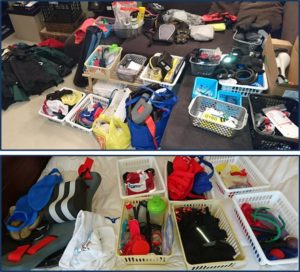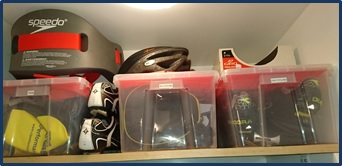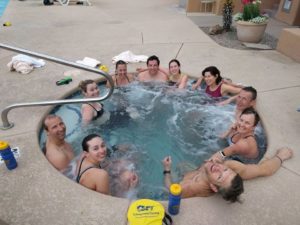Does this scenario sound familiar? You finished your season in September with a big race, followed by some well-earned down time. Three weeks later, the weather had changed, your return to training became focused on pool swims and sweating it out in the basement until spring arrives.
What about your gear? Chances are good that your bag is still stocked with last season’s remnants of nutrition, body glide, bike tools and a few swim caps.
This is a great time to get your gear sorted out and organized so you feel ready for the coming season. It might also be inspirational, which goes a long way when waiting for the rainy spring days to pass.
Here are a few tips for tackling the job, from Sandie Orlando, a professional organizer, who also trains year round.
- This will take a few hours, so allow yourself enough time to finish what you start.
- Gather everything together in one room and make some space on the floor, table, couch, bed to spread everything out.
- Take everything out of every bag, drawer and back pack. Everything! The goal is to see exactly what you’ve got. It might surprise you to realize how many duplicates you own. Even better…you might just find the sunglasses you thought were lost.

- Sort like things with like. Use small baskets or boxes to collect the smaller parts, and larger spaces to separate out all the shorts, socks, t-shirts, caps etc. The more specific you can get these piles, the better. Sub-sort larger categories to further narrow down the piles. Set aside any orphan socks for matching. Separate training gear from event or race gear…these items are considered differently. (see below)
- Time to let things go. Be realistic about what you actually use and hold your own feet to the fire. Does it fit properly? Is it in good condition? Did you use it at all last season? Could it be sold or donated? Is it so well loved that it should really be thrown away? Could it be kept in your car or office for an unscheduled workout? If you can’t honestly justify keeping it – let it go.
- Race jackets, event jerseys, and finisher caps all came at an extraordinary cost, one way or another, so souvenir gear is particularly difficult to part with. If you have storage space and feel really attached to these items, get some plastic bins and pack it away. Even better, get it framed along with your medal or race photo. If it’s just taking up space and doesn’t really inspire you, maybe the race bib or finisher photo is a sufficient keepsake, and the t-shirt can go.
- Water bottles tend to pile up at an alarming rate. It’s worth taking a close look at those bottles to see if they are harboring mould inside the drink spout, or have developed a strange odour. Leaky spouts and mismatched lids aren’t worth the hassle. While you’re at it – you might also want to weed out your collection of insulated coffee mugs!
- Check expiry dates on your nutrition and look for half-eaten bars and chews that should be tossed. Check the can of sport drink powder and toss the solidified ones.
- Take a look at the condition of your accessories. Anything that is orphaned, crunchy, stinky or shredded is unlikely to be missed. The same goes for irrelevant gadgets. If you haven’t found a use for it yet, why would you this season?
- Check your bike tool kit to make sure all of the important parts are still there and in good condition. You don’t need to flat on your first outdoor ride and discover that your tool kit is missing an inner tube or CO2 cartridge.
- Clean things! Tools function better. Zippers close properly. Small parts don’t get stuck together. Any clothing that has a residual smell should either be soaked and treated with a sport wash or tossed. If it smells when its dry…it will be ten times worse when you start to sweat in it! Your friends will thank you.

- Organize your storage spaces. If you’ve been diligent, you’ll have less to put away, which means more space to work with. Setting up two or three locations can work if you like to keep clothes, gear or nutrition close to where you’ll be packing or using them.
- Keep things contained in plastic bins with lids or baskets, and store like items together. Label the bins to help keep your system functional throughout the season.
- Being organized poses a challenge for triathletes because of the number of workouts each week in different locations – each requiring specific items. Try organizing the items you need for a gym or pool workout together, and pack your gym bag according to the workout planned for the next day. Keep outdoor gear together so you can grab everything you need for a long ride or open water swim from one location, without forgetting important accessories.

- Practice “buy one/discard one”. When you buy new cycling shorts, throw out an old pair. Investing in new goggles? Throw out your oldest pair (but always keep those back-ups!) One pair of running shoes in…one pair out.
- Don’t forget about your car. Digging around in a jumble of bags in your trunk wastes time and increases the chance of misplacing or forgetting things. Set up a system for keeping everything you need packed and ready to go. A small bin with a lid is a great place to store gloves, arm warmers, sunglasses, sun screen and lip balm. Think of it as good practice for setting up your transition.
- Nailing nutrition is always a challenge, and it starts with having the right supplies on hand to support your training on long and busy days. A large cooler bag to carry hydration and nutrition for a day, plus the accessories to manage a post ride lunch could make a difference for a healthier season.



